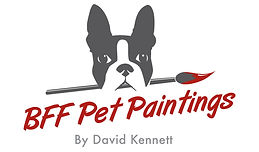Dog Painting Tutorial
I’ve had a few people ask me over the past year if I teach workshops or if I could give some tips on painting dogs. So, I’ve decided to put this blog together to share some of my process. Having painted about 160 custom pet painting over the last three years, I feel I’ve l
earned by practice and fine tuning my technique to paint faster and more easily portray what I’m trying to portray. The exciting thing is that there are still a million different ways to paint and I’m very excited to try some of them. What will my work look like in five years? I start the process by cropping my images in Picasa which is a free download from Google. picasa.google.com/.

I usually crop the picture a few times in different proportions for the various canvas sizes I offer. In addition to cropping I adjust the colors, usually just by pressing the “I’m feeling lucky” button. This process is all pretty easy in Picasa. Up next I use Photoshop to create a 1” grid. I know most people don’t have Photoshop and I have not taken the time to find an alternative for creating a 1” grid. I’d be very interested to know if any of you know a program that creates 1” grids on images.

By creating a 1” grid on the image, I can then create the same grid with pencil on my canvas. To save the grid from Photoshop, I take a screen shot in Photoshop while Picasa photo editor is open, the image automatically opens in Picasa where I crop out everything but the image and numbers around it. I then save that JPG and whala! I have my image to work from.
Next up I draw a 1” grid on my canvas and draw the image in. This allows me to get an accurate drawing and saves me time in the long run. Well, actually practicing drawing and getting really really good so I don’t even need the grid would probably save me the most time in the long run but for now, this is how I do it.

The more detail the better. It saves time when it comes to painting. I draw in hair direction, block in changes in light on hair and darken the dark sections.
After the image is on I take Golden brand Cadmium Red Medium Hue and paint a single layer over the canvas. This red is translucent and allows me to see the pencil lines underneath. The red provides a nice base coat. Instead of having little white spots coming through I have a nice warm red color.

Hard to see in this image but the pencil lines are there.
To get started I usually start with the eyes so I can rest my hand on the canvas then all the darkest parts of the painting. I have found the key is to paint from dark to light. Often any light part we see is a highlight on a darker subsurface so these layers must be built up. It’s tough to have the patience at first to know that all the dark being painted in is going to come together but the layers are important. Even white dog’s have shadows and in those shadows there are highlights.
So, if we paint the area as dark as the darkest part and then ad lighter colors on top, you can get something close to lifelike.


I try to paint in a majority of the painting in one go. That means the dark parts in a thin layer and the highlights that go over them with slightly thicker paint. This way the lighter color will cover the thin layer. If the bottom darker layer were done in thick paint it would smear and blend in with the next layer. This is called painting thin to thick. Note you can only paint the same part so much before it gets a little muddy. Using thicker paint on the outer layer allows you to get some texture and solid color with only some of the dark under layer still coming through.

I paint the figure of the dog before the background so that I can see the lines and numbers for a guide and so that I don’t get the background color mixed into the dog. Once done with my first go around on the dog I paint the background and then let it dry before going back in and finishing it all off.

Once dry, I go back into the painting and add details like hair details, hair that overlaps the background, highlights and darker shadows. Real life is full of contrast. Be sure to squint and look at your image to ensure it has the right values. Look at certain light areas in comparison to others. There are certain areas that are the lightest and the darkest and a bunch of areas in between. They are all relative to the whole, not just the area they are in. Getting the value right is important. It’s what makes the painting have depth and not look flat.












